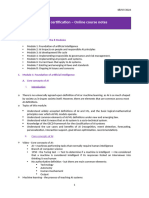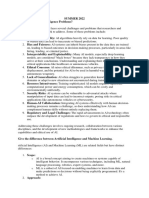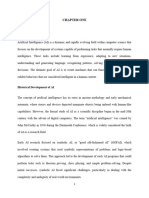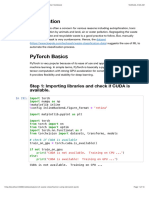Term Governance IA
Term Governance IA
Uploaded by
Josue FamaCopyright:
Available Formats
Term Governance IA
Term Governance IA
Uploaded by
Josue FamaOriginal Title
Copyright
Available Formats
Share this document
Did you find this document useful?
Is this content inappropriate?
Copyright:
Available Formats
Term Governance IA
Term Governance IA
Uploaded by
Josue FamaCopyright:
Available Formats
Key Terms for AI Governance
The field of artificial intelligence is rapidly evolving across different sectors and disparate industries, leaving business,
technology and government professionals without a common lexicon and shared understanding of terms and phrases
used in AI governance. Even a search to define "artificial intelligence" returns a range of definitions and examples. From
the cinematic, like HAL 9000 from "2001: A Space Odyssey," to the creative, like Midjourney and DALL-E generative
art, to the common, like email autocorrect and mobile maps, the use cases and applications of AI continue to grow and
expand into all aspects of life.
This glossary was developed with reference to numerous materials and designed to provide succinct, but nuanced,
definitions and explanations for some of the most common terms related to AI today. The explanations aim to present
both policy and technical perspectives and add to the robust discourse on AI governance. Although there are some
shared terms and definitions, this glossary is separate from the official IAPP Glossary of Privacy Terms.
A B C D E F G H I L M N O P R S T U V Key terms
TERM DEFINITION
The obligation and responsibility of the creators, operators and regulators of an AI system
to ensure the system operates in a manner that is ethical, fair, transparent and compliant
Accountability1 with applicable rules and regulations (see fairness and transparency). Accountability
ensures that actions, decisions and outcomes of an AI system can be traced back to the
entity responsible for it.
A subfield of AI and machine learning where an algorithm can select some of the data it
learns from. Instead of learning from all the data it is given, an active learning model requests
Active learning additional data points that will help it learn the best.
→ Also called query learning.
A system of policies, practices and processes organizations implement to manage and
oversee their use of AI technology and associated risks to ensure the AI aligns with an
AI governance
organization’s objectives, is developed and used responsibly and ethically, and complies with
applicable legal requirements.
A computational procedure or set of instructions and rules designed to perform a specific
Algorithm task, solve a particular problem or produce a machine learning or AI model (see machine
learning model).
Key Terms for AI Governance 1
A B C D E F G H I L M N O P R S T U V Key terms
TERM DEFINITION
AI that is considered to have human-level intelligence and strong generalization capability to
achieve goals and carry out a variety of tasks in different contexts and environments. AGI is
Artificial general still considered a theoretical field of research and contrasted with "narrow" AI, which is used
intelligence for specific tasks or problems.
→ Acronym: AGI
Artificial intelligence is a broad term used to describe an engineered system where
machines learn from experience, adjusting to new inputs (see input data) and potentially
performing tasks previously done by humans. More specifically, it is a field of computer
Artificial intelligence science dedicated to simulating intelligent behavior in computers. It may include automated
decision‑making.
→ Acronym: AI
Automated
The process of making a decision by technological means without human involvement.
decision-making
There are several types of bias within the AI field. Computational bias is a systematic error
or deviation from the true value of a prediction that originates from a model’s assumptions
or the data itself (see input data). Cognitive bias refers to inaccurate individual judgment
Bias
or distorted thinking, while societal bias leads to systemic prejudice, favoritism, and/or
discrimination in favor of or against an individual or group. Bias can impact outcomes and
pose a risk to individual rights and liberties.
A machine learning method that aggregates multiple versions of a model (see machine
learning model) trained on random subsets of a data set. This method aims to make a model
Bootstrap aggregating more stable and accurate.
→ Sometimes referred to as bagging.
A form of AI designed to simulate human-like conversations and interactions that uses
natural language processing to understand and respond to text or other media. Because
Chatbot
chatbots are often used for customer service and other personal help applications, chatbots
often ingest users’ personal information.
Classification model A type of model (see machine learning model) used in machine learning that is designed
(Classifiers) to take input data and sort it into different categories or classes.
Clustering An unsupervised machine learning method where patterns in the data are identified and
(or clustering algorithms) evaluated, and data points are grouped accordingly into clusters based on their similarity.
A field of AI that enables computers to process and analyze images, videos and other
Computer vision
visual inputs.
An analysis, often performed by a third-party body, on an AI system to determine
Conformity assessment whether requirements, such as establishing a risk management system, data governance,
record-keeping, transparency and cybersecurity practices have been met.
Key Terms for AI Governance 2
A B C D E F G H I L M N O P R S T U V Key terms
TERM DEFINITION
The principle of ensuring that AI systems and their decision-making processes can be
questioned or challenged. This ability to contest or challenge the outcomes, outputs
Contestability and/or actions of AI systems can help promote transparency and accountability within
AI governance.
→ Also called redress.
A large collection of texts or data that a computer uses to find patterns, make predictions
Corpus or generate specific outcomes. The corpus may include structured or unstructured data and
cover a specific topic or a variety of topics.
A type of supervised learning model used in machine learning (see machine learning model)
Decision tree
that represents decisions and their potential consequences in a branching structure.
A subfield of AI and machine learning that uses artificial neural networks. Deep learning
Deep learning is especially useful in fields where raw data needs to be processed, like image recognition,
natural language processing and speech recognition.
A type of model (see machine learning model) used in machine learning that directly maps
input features to class labels and analyzes for patterns that can help distinguish between
Discriminative model
different classes. It is often used for text classification tasks, like identifying the language of a
piece of text. Examples are traditional neural networks, decision trees and random forests.
The measure of unpredictability or randomness in a set of data used in machine learning.
Entropy
A higher entropy signifies greater uncertainty in predicting outcomes.
A form of AI that draws inferences from a knowledge base to replicate the decision-making
Expert system
abilities of a human expert within a specific field, like a medical diagnosis.
The ability to describe or provide sufficient information about how an AI system generates
a specific output or arrives at a decision in a specific context to a predetermined addressee.
Explainability XAI is important in maintaining transparency and trust in AI.
→ Acronym: XAI
Data discovery process techniques that take place before training a machine learning model
Exploratory data analysis in order to gain preliminary insights into a data set, such as identifying patterns, outliers, and
anomalies and finding relationships among variables.
An attribute of an AI system that ensures equal and unbiased treatment of individuals or
Fairness 1 groups in its decisions and actions in a consistent, accurate manner. It means the AI system’s
decisions should not be affected by certain sensitive attributes like race, gender or religion.
A machine learning method that allows models (see machine learning model) to be trained
on the local data of multiple edge devices or servers. Only the updates of the local model, not
Federated learning
the training data itself, are sent to a central location where they get aggregated into a global
model — a process that is iterated until the global model is fully trained.
Key Terms for AI Governance 3
A B C D E F G H I L M N O P R S T U V Key terms
TERM DEFINITION
A large-scale, pretrained model for AI capabilities, such as language (see large language
Foundation model model), vision, robotics, reasoning, search or human interaction, that can function as the
base for other applications. The model is trained on extensive and diverse data sets.
The ability of a model (see machine learning model) to understand the underlying patterns
Generalization and trends in its training data and apply what it has learned to make predictions or decisions
about new, unseen data.
A field of AI that uses machine learning models trained on large data sets to create new
Generative AI content, such as written text, code, images, music, simulations and videos. These models
are capable of generating novel outputs based on input data or user prompts.
A type of algorithm that makes the optimal choice to achieve an immediate objective at a
Greedy algorithms particular step or decision point, based on the available information and without regard for
the longer-term optimal solution.
Instances where a generative AI model creates content that either contradicts the source or
Hallucinations
creates factually incorrect outputs under the appearance of fact.
A type of machine learning process where a trained model (see machine learning model)
Inference
is used to make predictions or decisions based on input data.
Data provided to or directly acquired by a learning algorithm or model (see machine learning
Input data model) for the purpose of producing an output. It forms the basis upon which the machine
learning model will learn, make predictions and/or carry out tasks.
A form of AI that utilizes deep learning algorithms to create models (see machine learning
model) trained on massive text data sets to analyze and learn patterns and relationships
among characters, words and phrases. There are generally two types of LLMs: generative
models that make text predictions based on the probabilities of word sequences learned
Large language model from its training data (see generative AI) and discriminative models that make classification
predictions based on probabilities of data features and weights learned from its training
data (see discriminative model). The term "large" generally refers to the model’s capacity
measured by the number of parameters.
→ Acronym: LLM
A subfield of AI involving algorithms that enable computer systems to iteratively learn from
and then make decisions, inferences or predictions based on data (see input data). These
algorithms build a model from training data to perform a specific task on new data without
being explicitly programmed to do so.
Machine learning implements various algorithms that learn and improve by experience in
Machine learning
a problem-solving process that includes data cleansing, feature selection, training, testing
and validation. Companies and government agencies deploy machine learning algorithms for
tasks such as fraud detection, recommender systems, customer inquiries, natural language
processing, health care, or transport and logistics.
→ Acronym: ML
Key Terms for AI Governance 4
A B C D E F G H I L M N O P R S T U V Key terms
TERM DEFINITION
A learned representation of underlying patterns and relationships in data, created by applying
Machine learning model an AI algorithm to a training data set. The model can then be used to make predictions or
perform tasks on new, unseen data.
A type of model used in machine learning (see machine learning model) that can process
more than one type of input or output data, or "modality," at the same time. For example,
a multimodal model can take both an image and text caption as input and then produce a
Multimodal models
unimodal output in the form of a score indicating how well the text caption describes the
image. These models are highly versatile and useful in a variety of tasks, like image captioning
and speech recognition.
A subfield of AI that helps computers understand, interpret and manipulate human language
Natural language by transforming information into content. It enables machines to read text or spoken
processing language, interpret its meaning, measure sentiment, and determine which parts are important
for understanding.
A type of model (see machine learning model) used in machine learning that mimics the
way neurons in the brain interact with multiple processing layers, including at least one
Neural networks hidden layer. This layered approach enables neural networks to model complex nonlinear
relationships and patterns within data. Artificial neural networks have a range of applications,
such as image recognition and medical diagnosis.
A concept in machine learning in which a model (see machine learning model) becomes too
Overfitting specific to the training data and cannot generalize to unseen data, which means it can fail to
make accurate predictions on new data sets.
The process of effectively monitoring and supervising an AI system to minimize risks, ensure
regulatory compliance and uphold responsible practices. Oversight is important for effective
Oversight
AI governance, and mechanisms may include certification processes, conformity assessments
and regulatory authorities responsible for enforcement.
Steps performed after a machine learning model has been run to adjust the output of that
model. This can include adjusting a model’s outputs and/or using a holdout data set —
Post processing
data not used in the training of the model — to create a function that runs on the model’s
predictions to improve fairness or meet business requirements.
Steps taken to prepare data for a machine learning model, which can include cleaning the
data, handling missing values, normalization, feature extraction and encoding categorical
Preprocessing variables. Data preprocessing can play a crucial role in improving data quality, mitigating bias,
addressing algorithmic fairness concerns, and enhancing the performance and reliability of
machine learning algorithms.
A supervised machine learning (see supervised learning) algorithm that builds multiple
decision trees and merges them together to get a more accurate and stable prediction. Each
Random forest decision tree is built with a random subset of the training data (see bootstrap aggregating),
hence the name "random forest." Random forests are helpful to use with data sets that are
missing values or very complex.
Key Terms for AI Governance 5
A B C D E F G H I L M N O P R S T U V Key terms
TERM DEFINITION
A machine learning method that trains a model to optimize its actions within a given
environment to achieve a specific goal, guided by feedback mechanisms of rewards and
penalties. This training is often conducted through trial-and-error interactions or simulated
Reinforcement learning
experiences that do not require external data. For example, an algorithm can be trained to
earn a high score in a video game by having its efforts evaluated and rated according to
success toward the goal.
An attribute of an AI system that ensures it behaves as expected and performs its intended
Reliability
function consistently and accurately, even with new data that it has not been trained on.
A multidisciplinary field that encompasses the design, construction, operation and
Robotics programming of robots. Robotics allow AI systems and software to interact with the
physical world.
An attribute of an AI system that ensures a resilient system that maintains its functionality
Robustness and performs accurately in a variety of environments and circumstances, even when faced
with changed inputs or an adversarial attack.
The development of AI systems that are designed to minimize potential harm to individuals,
Safety
society, property and the environment.
A subset of machine learning where the model (see machine learning model) is trained on
input data with known desired outputs. These two groups of data are sometimes called
Supervised learning predictors and targets, or independent and dependent variables, respectively. This type
of learning is useful for training an AI to group data into specific categories or making
predictions by understanding the relationship between two variables.
Data generated by a system or model (see machine learning model) that can mimic and
resemble the structure and statistical properties of real data. It is often used for testing
Synthetic data
or training machine learning models, particularly in cases where real-world data is limited,
unavailable or too sensitive to use.
A subset of the data set used to provide an unbiased evaluation of a final model (see
Testing data machine learning model). It is used to test the performance of the machine learning model
with new data at the very end of the model development process.
A subset of the data set that is used to train a model (see machine learning model) until it
Training data
can accurately predict outcomes, find patterns or identify structures within the training data.
A type of model (see machine learning model) used in machine learning in which an
Transfer learning model algorithm learns to perform one task, such as recognizing cats, and then uses that learned
knowledge as a basis when learning a different but related task, such as recognizing dogs.
The extent to which information regarding an AI system is made available to stakeholders,
Transparency1 including if one is used and an explanation of how it works. It implies openness,
comprehensibility and accountability in the way AI algorithms function and make decisions.
Key Terms for AI Governance 6
A B C D E F G H I L M N O P R S T U V Key terms
TERM DEFINITION
In most cases this is used interchangeably with the terms responsible AI and ethical AI,
which all refer to principle-based AI development and governance (see AI governance),
Trustworthy AI
including the principles of security, safety, transparency, explainability, accountability, privacy,
nondiscrimination/nonbias (see bias), among others.
A test of a machine’s ability to exhibit intelligent behavior equivalent to, or indistinguishable
Turing test from, that of a human. Alan Turing (1912-1954) originally thought of the test to be an AI’s
ability to converse through a written text.
A concept in machine learning in which a model (see machine learning model) fails to fully
capture the complexity of the training data. This may result in poor predictive ability and/or
Underfitting inaccurate outputs. Factors leading to underfitting may include too few model parameters or
epochs, having too high a regularization rate, or using an inappropriate or insufficient set of
features in the training data.
A subset of machine learning where the model is trained by looking for patterns in an
unclassified data set with minimal human supervision. The AI is provided with preexisting
Unsupervised learning data sets and then analyzes those data sets for patterns. This type of learning is useful
for training an AI for techniques such as clustering data (outlier detection, etc.) and
dimensionality reduction (feature learning, principal component analysis, etc.).
A subset of the data set used to assess the performance of the model (see machine learning
Validation data model) during the training phase. Validation data is used to fine-tune the parameters of a
model and prevent overfitting before the final evaluation using the test data set.
In the context of machine learning, a variable is a measurable attribute, characteristic
Variables or unit that can take on different values. Variables can be numerical/quantitative or
categorical/qualitative.
A statistical measure that reflects how far a set of numbers are spread out from their
average value in a data set. A high variance indicates the data points are spread widely
around the mean. A low variance indicates the data points are close to the mean. In machine
Variance
learning, higher variance can lead to overfitting. The trade-off between variance and bias
is a fundamental concept in machine learning. Model complexity tends to reduce bias but
increase variance. Decreasing complexity reduces variance but increases bias.
Notes
1 Different definition than IAPP privacy training glossary.
More resources
ѕ AI Governance Center
ѕ AI topic page
ѕ AI Body of Knowledge
Key Terms for AI Governance 7
Key terms
Accountability . . . . . . . . . . . . . . . . . . . . . . . . . 1 Explainability . . . . . . . . . . . . . . . . . . . . . . . . . . 3 Random forest . . . . . . . . . . . . . . . . . . . . . . . . . 5
Active learning . . . . . . . . . . . . . . . . . . . . . . . . . 1 Exploratory data analysis . . . . . . . . . . . . . . . . 3 Reinforcement learning . . . . . . . . . . . . . . . . . 6
AI governance . . . . . . . . . . . . . . . . . . . . . . . . . 1 Fairness . . . . . . . . . . . . . . . . . . . . . . . . . . . . . . . 3 Reliability . . . . . . . . . . . . . . . . . . . . . . . . . . . . . . 6
Algorithm . . . . . . . . . . . . . . . . . . . . . . . . . . . . . 1 Federated learning . . . . . . . . . . . . . . . . . . . . . . 3 Robotics . . . . . . . . . . . . . . . . . . . . . . . . . . . . . . 6
Artificial general intelligence . . . . . . . . . . . . . 2 Foundation model . . . . . . . . . . . . . . . . . . . . . . 4 Robustness . . . . . . . . . . . . . . . . . . . . . . . . . . . . 6
Artificial intelligence . . . . . . . . . . . . . . . . . . . . 2 Generalization . . . . . . . . . . . . . . . . . . . . . . . . . 4 Safety . . . . . . . . . . . . . . . . . . . . . . . . . . . . . . . . . 6
Automated decision-making . . . . . . . . . . . . . 2 Generative AI . . . . . . . . . . . . . . . . . . . . . . . . . . 4 Supervised learning . . . . . . . . . . . . . . . . . . . . . 6
Bias . . . . . . . . . . . . . . . . . . . . . . . . . . . . . . . . . . . 2 Greedy algorithms . . . . . . . . . . . . . . . . . . . . . . 4 Synthetic data . . . . . . . . . . . . . . . . . . . . . . . . . 6
Bootstrap aggregating . . . . . . . . . . . . . . . . . . 2 Hallucinations . . . . . . . . . . . . . . . . . . . . . . . . . . 4 Testing data . . . . . . . . . . . . . . . . . . . . . . . . . . . 6
Chatbot . . . . . . . . . . . . . . . . . . . . . . . . . . . . . . . 2 Inference . . . . . . . . . . . . . . . . . . . . . . . . . . . . . . 4 Training data . . . . . . . . . . . . . . . . . . . . . . . . . . . 6
Classification model (Classifiers) . . . . . . . . . 2 Input data . . . . . . . . . . . . . . . . . . . . . . . . . . . . . 4 Transfer learning model . . . . . . . . . . . . . . . . . 6
Clustering (or clustering algorithms) . . . . . 2 Large language model . . . . . . . . . . . . . . . . . . 4 Transparency . . . . . . . . . . . . . . . . . . . . . . . . . . 6
Computer vision . . . . . . . . . . . . . . . . . . . . . . . 2 Machine learning . . . . . . . . . . . . . . . . . . . . . . . 4 Trustworthy AI . . . . . . . . . . . . . . . . . . . . . . . . . 7
Conformity assessment . . . . . . . . . . . . . . . . . 2 Machine learning model . . . . . . . . . . . . . . . . 5 Turing test . . . . . . . . . . . . . . . . . . . . . . . . . . . . . 7
Contestability . . . . . . . . . . . . . . . . . . . . . . . . . . 3 Multimodal models . . . . . . . . . . . . . . . . . . . . . 5 Underfitting . . . . . . . . . . . . . . . . . . . . . . . . . . . 7
Corpus . . . . . . . . . . . . . . . . . . . . . . . . . . . . . . . . 3 Natural language processing . . . . . . . . . . . . . 5 Unsupervised learning . . . . . . . . . . . . . . . . . . 7
Decision tree . . . . . . . . . . . . . . . . . . . . . . . . . . 3 Neural networks . . . . . . . . . . . . . . . . . . . . . . . 5 Validation data . . . . . . . . . . . . . . . . . . . . . . . . . 7
Deep learning . . . . . . . . . . . . . . . . . . . . . . . . . . 3 Overfitting . . . . . . . . . . . . . . . . . . . . . . . . . . . . . 5 Variables . . . . . . . . . . . . . . . . . . . . . . . . . . . . . . 7
Discriminative model . . . . . . . . . . . . . . . . . . . 3 Oversight . . . . . . . . . . . . . . . . . . . . . . . . . . . . . . 5 Variance . . . . . . . . . . . . . . . . . . . . . . . . . . . . . . . 7
Entropy . . . . . . . . . . . . . . . . . . . . . . . . . . . . . . . 3 Post processing . . . . . . . . . . . . . . . . . . . . . . . . 5
Expert system . . . . . . . . . . . . . . . . . . . . . . . . . 3 Preprocessing . . . . . . . . . . . . . . . . . . . . . . . . . . 5
IAPP disclaims all warranties, expressed or implied, with respect to the contents of this material, including any warranties
Key Terms for AI Governance Published June
8 2023
of accuracy, merchantability, or fitness for a particular purpose. Nothing herein should be construed as legal advice.
© 2023 International Association of Privacy Professionals. All rights reserved. Find the latest version at iapp.org/resources
You might also like
- Prasad Agrawal, K. (2023) - Towards Adoption of Generative AI in Organizational SettingsDocument17 pagesPrasad Agrawal, K. (2023) - Towards Adoption of Generative AI in Organizational Settings河清倫Luan0% (1)
- Key Terms For Ai GovernanceDocument10 pagesKey Terms For Ai GovernanceLucaNo ratings yet
- Key Terms For AI Governance - 1722523779Document13 pagesKey Terms For AI Governance - 1722523779Randall EvangelistaNo ratings yet
- Copy of Indian AI Tech Project Proposal by SlidesgoDocument16 pagesCopy of Indian AI Tech Project Proposal by SlidesgoMOHIT SAVLIYANo ratings yet
- Artificial Intelligence GlossaryDocument2 pagesArtificial Intelligence GlossaryJohnNo ratings yet
- Introduction To Artificial Intelligence Machine Learning and Data Science in Mechanical EngineeringDocument24 pagesIntroduction To Artificial Intelligence Machine Learning and Data Science in Mechanical EngineeringlawrancedevarajNo ratings yet
- Class 9 (AI Notes and Question Updated Syllabus)Document104 pagesClass 9 (AI Notes and Question Updated Syllabus)svverma1982No ratings yet
- Research Paper On AIDocument16 pagesResearch Paper On AICradle StarkNo ratings yet
- Pathfinder Glossary Web FinalDocument4 pagesPathfinder Glossary Web Finalassistant0849No ratings yet
- The 3 R's of AI Adoption: Refactor. Reinvent. ReimagineDocument23 pagesThe 3 R's of AI Adoption: Refactor. Reinvent. ReimagineRajesh AbichandaniNo ratings yet
- NASSCOM AI Top 50 Use Cases Final PDFDocument85 pagesNASSCOM AI Top 50 Use Cases Final PDFSiddharth SuvNo ratings yet
- The Ethics and Norms of Artificial Intelligence (AI)Document3 pagesThe Ethics and Norms of Artificial Intelligence (AI)International Journal of Innovative Science and Research TechnologyNo ratings yet
- Unit 5 - AI - Part1Document7 pagesUnit 5 - AI - Part1tratratam49No ratings yet
- Beneficios de La Ai Ahora y en El Futuro - Software y HardwareDocument13 pagesBeneficios de La Ai Ahora y en El Futuro - Software y HardwareCarlos BernalesNo ratings yet
- What Are The Advantages and Disadvantages of Artificial IntelligenceDocument9 pagesWhat Are The Advantages and Disadvantages of Artificial IntelligenceNdidi KennedyNo ratings yet
- AI Presentation Machine LearningDocument42 pagesAI Presentation Machine LearningXoha Fatima100% (1)
- Herbert Smith Freehills Submission 1691724095Document12 pagesHerbert Smith Freehills Submission 1691724095aldykurniawanNo ratings yet
- Unit IiDocument20 pagesUnit IifunnymonmetsNo ratings yet
- Glossary: Harnessing The Disruption of Generative AI: Term ExplanationDocument15 pagesGlossary: Harnessing The Disruption of Generative AI: Term ExplanationWAWAN RUSWANANo ratings yet
- Artificial Intelligence AIDocument10 pagesArtificial Intelligence AIta0.7.9.8420.2No ratings yet
- AI Presentation v2Document30 pagesAI Presentation v2sagarsg13No ratings yet
- 5 Key Ways Ai Can Supercharge ObservabilityDocument10 pages5 Key Ways Ai Can Supercharge ObservabilitymichNo ratings yet
- Pds Notes ML Unit4Document13 pagesPds Notes ML Unit4211cs011No ratings yet
- 3 Artificial IntelligenceDocument24 pages3 Artificial Intelligencekigali acNo ratings yet
- Extra NotesICT and AI ReflectionDocument12 pagesExtra NotesICT and AI ReflectionD wolf's editsNo ratings yet
- Artificial Intelligence For Business - A Comprehensive Guide to AI Integration: Series 1From EverandArtificial Intelligence For Business - A Comprehensive Guide to AI Integration: Series 1No ratings yet
- Introduction To Artificial IntelligenceDocument18 pagesIntroduction To Artificial IntelligenceJoan EbordeNo ratings yet
- Artificial IntelligenceDocument26 pagesArtificial IntelligencekueiyieeNo ratings yet
- AI Unleashed: A Holistic Guide to Mastering Artificial Intelligence: Navigating Theory, Implementation, and Ethical FrontiersFrom EverandAI Unleashed: A Holistic Guide to Mastering Artificial Intelligence: Navigating Theory, Implementation, and Ethical FrontiersNo ratings yet
- McKinsey202209 Why Businesses Need Explainable Ai and How To Deliver ItDocument5 pagesMcKinsey202209 Why Businesses Need Explainable Ai and How To Deliver Itstrings cnNo ratings yet
- Emerging Technologies in BusinessDocument35 pagesEmerging Technologies in BusinesshimanshuNo ratings yet
- 4.1. Notes ( 60 Min) - Eduvos ITAIADocument6 pages4.1. Notes ( 60 Min) - Eduvos ITAIAmariann.jardineNo ratings yet
- Horizon Scanning Artificial Intelligence Legal Profession May 2018 PDFDocument20 pagesHorizon Scanning Artificial Intelligence Legal Profession May 2018 PDFyuvasree talapaneniNo ratings yet
- Arti Cial Intelligence and Machine LearningDocument6 pagesArti Cial Intelligence and Machine Learningnwagwukelechi646No ratings yet
- Explainable Artificial Intelligence ApproachesDocument14 pagesExplainable Artificial Intelligence Approachesghrab MedNo ratings yet
- GlosaryDocument3 pagesGlosaryCode NameNo ratings yet
- AIGP Online Class NotesDocument85 pagesAIGP Online Class NotesMishilicious MishiNo ratings yet
- Artificial Intelligence: Decoding AI For Internal Audit Pankaj Kumar Ca, Cfa, IsaDocument9 pagesArtificial Intelligence: Decoding AI For Internal Audit Pankaj Kumar Ca, Cfa, Isabooks oneNo ratings yet
- Artificial IntelligenceDocument11 pagesArtificial Intelligencemanasranjanbhadra577No ratings yet
- Summer 2022Document26 pagesSummer 2022200130111057No ratings yet
- Mitre A Sensible Regulatory Framework For Ai Security 1700943294Document13 pagesMitre A Sensible Regulatory Framework For Ai Security 1700943294Roger SenNo ratings yet
- RBC and Artificial IntelligenceDocument9 pagesRBC and Artificial Intelligencewanyama DenisNo ratings yet
- Artificial IntelligenceDocument16 pagesArtificial Intelligenceikechukwuchinonso537No ratings yet
- Class 10 Ai Holiday HomeworkDocument8 pagesClass 10 Ai Holiday HomeworkSarita RaoNo ratings yet
- AIDocument10 pagesAIjeetendra1980No ratings yet
- Ai 2Document7 pagesAi 2crjjdwnmvrNo ratings yet
- AI PPT Presentation Rev1Document29 pagesAI PPT Presentation Rev1TRIZZA100% (1)
- AI Corrections BriefDocument8 pagesAI Corrections BriefAnurag ChoudharyNo ratings yet
- 情报分析的未来人工智能对情报分析影响的任务级观点 20201020 提交Document20 pages情报分析的未来人工智能对情报分析影响的任务级观点 20201020 提交chou youNo ratings yet
- Krogh 2022 Naturepaper PDFDocument11 pagesKrogh 2022 Naturepaper PDFJerimNo ratings yet
- Ai PrinciplesDocument49 pagesAi PrinciplesEvelyn santiago felizzolaNo ratings yet
- Introduction of AI DevelopmentDocument8 pagesIntroduction of AI DevelopmentKeystrideNo ratings yet
- Exploring The Frontiers of Artificial IntelligenceDocument15 pagesExploring The Frontiers of Artificial Intelligencefayazitamana9No ratings yet
- Use of Adaptive Boosting Algorithm To Estimate User's Trust in The Utilization of Virtual Assistant SystemsDocument6 pagesUse of Adaptive Boosting Algorithm To Estimate User's Trust in The Utilization of Virtual Assistant SystemsInternational Journal of Innovative Science and Research TechnologyNo ratings yet
- Aritificial Intelligence Lecture 1 Notes Ur Engineering Friend 1Document8 pagesAritificial Intelligence Lecture 1 Notes Ur Engineering Friend 1Anushka kolteNo ratings yet
- 1 Unit Artificial IntelligenceDocument7 pages1 Unit Artificial Intelligencemudassir mdNo ratings yet
- UNIT 5Document125 pagesUNIT 5vanieswari762002No ratings yet
- IJMIE4March24 11582Document10 pagesIJMIE4March24 11582editorijmieNo ratings yet
- What Are The Ethics in Artificial Intelligence (AI)Document7 pagesWhat Are The Ethics in Artificial Intelligence (AI)Nezaket Sule ErturkNo ratings yet
- USAID AI Ethics Guide - 1Document17 pagesUSAID AI Ethics Guide - 1EM PatindolNo ratings yet
- Great Biblical Commentators - DrARockDocument41 pagesGreat Biblical Commentators - DrARockJosue FamaNo ratings yet
- Consumer Privacy and Data Protection BOOKDocument15 pagesConsumer Privacy and Data Protection BOOKJosue FamaNo ratings yet
- Heavenly Torah As Refracted Through The Generations by Heschel, Abraham Joshua, 1907-1972, AuthorDocument854 pagesHeavenly Torah As Refracted Through The Generations by Heschel, Abraham Joshua, 1907-1972, AuthorJosue Fama100% (2)
- The Light of The Eyes Homilies On The Torah by Rabbi Menachem Nahum of Chernobyl Arthur GreenDocument879 pagesThe Light of The Eyes Homilies On The Torah by Rabbi Menachem Nahum of Chernobyl Arthur GreenJosue FamaNo ratings yet
- TNO - Connecting Changing Accelerating - TNO Strategy 2022 - 2025 - CompressedDocument104 pagesTNO - Connecting Changing Accelerating - TNO Strategy 2022 - 2025 - CompressedJosue FamaNo ratings yet
- Object Detection of The Bornean Orangutan Nests Using Drone and YOLOv5Document10 pagesObject Detection of The Bornean Orangutan Nests Using Drone and YOLOv5IAES IJAINo ratings yet
- Clement-Rambour SEN12-FLOOD Isprs2020 FinalDocument4 pagesClement-Rambour SEN12-FLOOD Isprs2020 Finalpratyaush2015No ratings yet
- SVIA Dataset A New Dataset of Microscopic Videos - 2022 - Biocybernetics and BiDocument11 pagesSVIA Dataset A New Dataset of Microscopic Videos - 2022 - Biocybernetics and BiThang VietNo ratings yet
- 1 s2.0 S0378778822003176 MainDocument15 pages1 s2.0 S0378778822003176 MainMarlon RibeiroNo ratings yet
- On The Cross-Dataset Generalization in License Plate RecognitionDocument13 pagesOn The Cross-Dataset Generalization in License Plate RecognitionRayson LarocaNo ratings yet
- The Machine Learning Solutions Architect Handbook - 2nd Edition (Early Access) David Ping All Chapter Instant DownloadDocument49 pagesThe Machine Learning Solutions Architect Handbook - 2nd Edition (Early Access) David Ping All Chapter Instant Downloadmekninnelyy100% (1)
- Enhancing Warehouse Operations Through Artificial Intelligence: Pallet Damage Classification With Deep Learning InsightsDocument8 pagesEnhancing Warehouse Operations Through Artificial Intelligence: Pallet Damage Classification With Deep Learning InsightsInternational Journal of Innovative Science and Research TechnologyNo ratings yet
- Deep Learning Feature ModelingDocument5 pagesDeep Learning Feature ModelingnubnajninNo ratings yet
- Chapter 5 - Machine LearningDocument59 pagesChapter 5 - Machine LearningabebawNo ratings yet
- Pytorch Waste Classification Using Densenet Jupyter NotebookDocument14 pagesPytorch Waste Classification Using Densenet Jupyter NotebookHitesh SariyaNo ratings yet
- What Is Supervised Machine LearningDocument3 pagesWhat Is Supervised Machine LearningMuhammad Tehseen QureshiNo ratings yet
- Electric Guitar Playing Style Feature Fusion Using Filter BanksDocument8 pagesElectric Guitar Playing Style Feature Fusion Using Filter Banksaryan.nair704No ratings yet
- Greenlightningai: An Efficient Ai System With Decoupled Structural and Quantitative KnowledgeDocument15 pagesGreenlightningai: An Efficient Ai System With Decoupled Structural and Quantitative Knowledgeyosamec917No ratings yet
- Final ReportDocument29 pagesFinal ReportManju ManikandanNo ratings yet
- ML 1 Lecture 2Document50 pagesML 1 Lecture 2Annayah UsmanNo ratings yet
- Study of Twitter Sentiment Analysis Using MachineDocument7 pagesStudy of Twitter Sentiment Analysis Using MachineBintang Putra SaylendraNo ratings yet
- APS1070 Lecture (3) SlidesDocument70 pagesAPS1070 Lecture (3) SlidesСаша ЦойNo ratings yet
- 1111 ChatGPT Prompts PDFDocument180 pages1111 ChatGPT Prompts PDFcontact.iseoaiNo ratings yet
- C-G1 2nd ReviewDocument114 pagesC-G1 2nd ReviewVippala SrijaNo ratings yet
- Helmet Detection System Using Mask R-CNNDocument8 pagesHelmet Detection System Using Mask R-CNNbryansantoso8585No ratings yet
- Neural Networks, Playground Exercises - Group 1Document15 pagesNeural Networks, Playground Exercises - Group 1syifa auliaNo ratings yet
- Applied SciencesDocument21 pagesApplied Sciencesseyfu mogesNo ratings yet
- Credit Card Fraud DetectDocument19 pagesCredit Card Fraud DetectVikas BankarNo ratings yet
- Kenny-230718-Top 70 Microsoft Data Science Interview QuestionsDocument17 pagesKenny-230718-Top 70 Microsoft Data Science Interview QuestionsvanjchaoNo ratings yet
- Active Online Learning For Social Media Analysis To Support Crisis ManagementDocument8 pagesActive Online Learning For Social Media Analysis To Support Crisis ManagementNarayanapally DeepikaNo ratings yet
- Rule Book DecembothonDocument37 pagesRule Book DecembothonMainak DasguptaNo ratings yet
- Pattern RecognitionDocument9 pagesPattern RecognitionPriya MauryaNo ratings yet
- Direct - Prediction - of - Steam - Cracking - Products - From - Naphta Bulk PropertiesDocument14 pagesDirect - Prediction - of - Steam - Cracking - Products - From - Naphta Bulk PropertiesCaro Ramírez Javier IvanNo ratings yet
- Data Mining Project Report - ReshmaDocument23 pagesData Mining Project Report - Reshmareshma ajithNo ratings yet
- LogiQA: A Challenge Dataset For Machine Reading Comprehension With Logical ReasoningDocument7 pagesLogiQA: A Challenge Dataset For Machine Reading Comprehension With Logical Reasoningyvonnewjy97No ratings yet






























































































